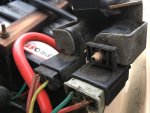clam_bert
New Member
- Joined
- Nov 5, 2016
- Messages
- 15
- Reaction score
- 0
- Points
- 1
- Location
- Louisville ky
- Vehicle Year
- 1986
- Make / Model
- Ford
- Engine Size
- 2.3
- Transmission
- Automatic
Hey guys,
I bought a nice old pawpaw owned ranger, low mileage, in good shape a couple months back, have given it a tuneup and timing belt change, but I haven't been able to figure out why the idle hunts slightly. It's also getting bad fuel mileage for the engine (about 15 city).
The other day I Finally tracked a pesky hissing noise back to the egr solenoid. Assumed it was a vacuum leak, and today found another solenoid in the local junk yard. However it makes the same hissing noise. The only time I can get it to stop is by removing the hoses and plugging them with my fingers. The idle evens out a bit when I do that as well.
Is it possible I just have two faulty solenoids and need to shell out 70.00 for a new one? what can I do to check before spending the money and potentially wasting it? Any other advice?
I bought a nice old pawpaw owned ranger, low mileage, in good shape a couple months back, have given it a tuneup and timing belt change, but I haven't been able to figure out why the idle hunts slightly. It's also getting bad fuel mileage for the engine (about 15 city).
The other day I Finally tracked a pesky hissing noise back to the egr solenoid. Assumed it was a vacuum leak, and today found another solenoid in the local junk yard. However it makes the same hissing noise. The only time I can get it to stop is by removing the hoses and plugging them with my fingers. The idle evens out a bit when I do that as well.
Is it possible I just have two faulty solenoids and need to shell out 70.00 for a new one? what can I do to check before spending the money and potentially wasting it? Any other advice?
















